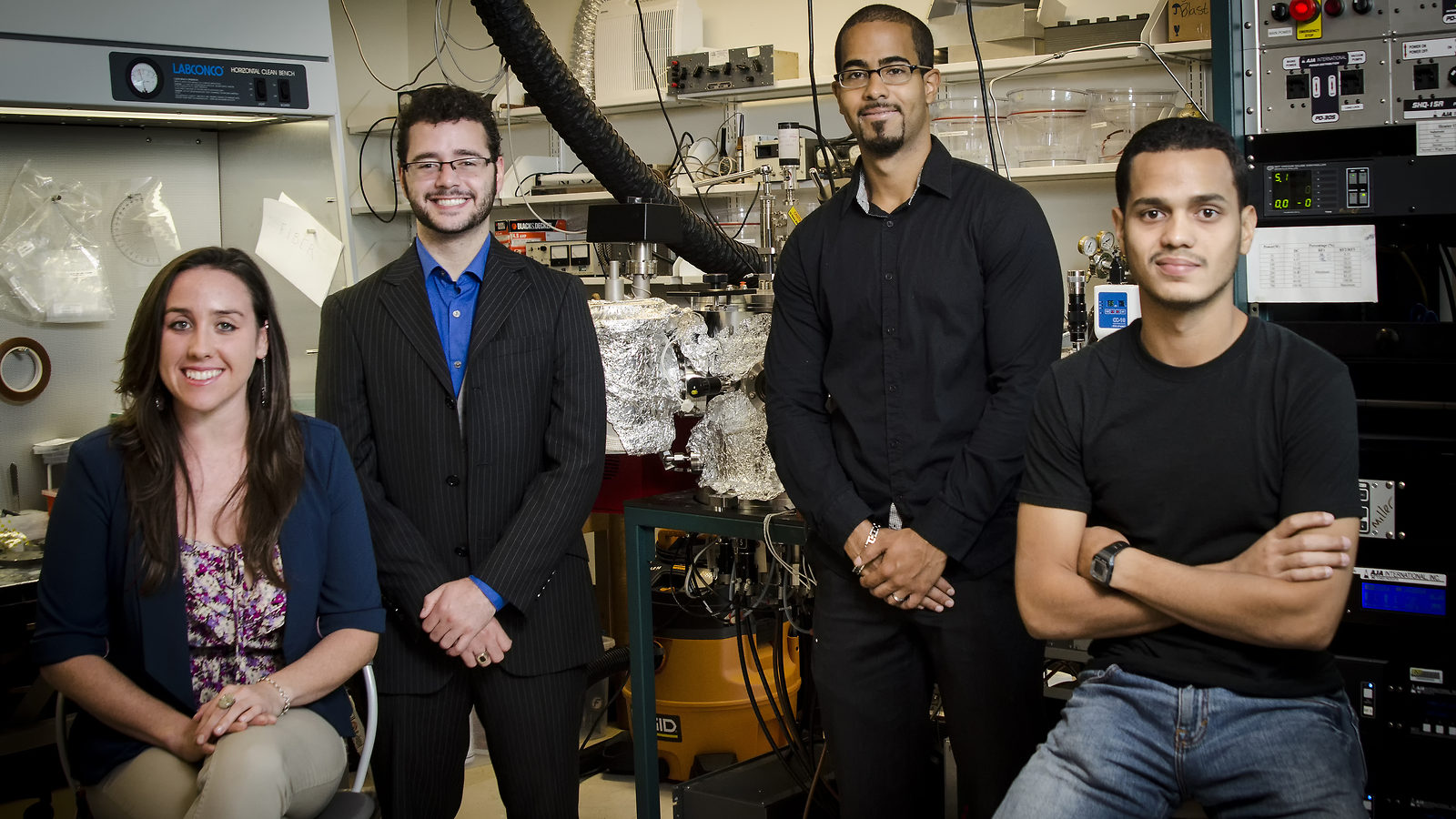Carlos Perez, a physics graduate student at the University of South Florida, can tell you all about his research studying exotic materials that could be key to developing next-generation solar panels. He can also tell you how it almost didn’t happen.
Perez (above, second from right) says he was first inspired to go into physics by a teacher at his high school in New York. The teacher ran an after-school program that trained students to comprehend and discuss research papers.
“He really went above and beyond,” Perez says. “He really tried to show us the fundamentals of what you need to know in physics and how it’s a really beautiful science.”
After high school, Perez was accepted to Brandeis University near Boston and pursued an undergraduate degree in biophysics. He was the first member of his family to attend college.
Near the end of his senior year, he knew it was time to apply to graduate school.
“I was so busy with my coursework that I didn’t start or apply early enough,” he says. “And money was very tight for me. The idea of shelling out $200 to $400 on college applications was very daunting.”
He managed to apply to only a handful of schools. He was rejected by every one.
So he filled out one more application—to the American Physical Society Bridge Program. The APS Bridge Program gives a second chance to potential physics doctoral candidates from underrepresented groups.
In the United States, fewer than 10 percent of bachelor’s degrees in physics are typically awarded to underrepresented ethnic minorities, according to the National Center for Education Statistics. That share falls below 6 percent for doctoral degrees.
The near-term goal of the Bridge Program is to eliminate that drop-off between bachelor’s programs and doctoral programs.
Ted Hodapp, the director of education and diversity at APS, spearheaded the launch of the Bridge Program in 2008. It received funding in 2012 in the form of a five-year grant from the National Science Foundation. Applicants must be US citizens or permanent residents.
Students from underrepresented groups wind up changing their plans to pursue physics PhDs for several different reasons, Hodapp says.
“Some could not afford to apply to enough institutions to get accepted,” he says. “A number of students applied to a few places and didn’t get accepted and so they gave up. In some cases they did not receive or follow good advice on what sorts of institutions they should apply to.”
The Bridge Program helps guide students through the application process and then sends their materials to more than 70 institutions that have agreed to give them a second look, free of charge.
In addition, four formal Bridge Program Sites—California State University, Long Beach; Florida State University; The Ohio State University; and University of South Florida—receive NSF funding to run special mentoring programs. Other institutions, such as Vanderbilt University and the University of Michigan, have created similar mentoring programs of their own.
In the Bridge Program’s first year, 13 students were accepted to graduate physics programs. Twenty-five applicants were placed in 2014.
The APS requires program sites to closely track students and aid them in their transition to graduate school, especially in their first semester, Hodapp says.
“They make sure they are getting matched with the right people, that they get experience with research,” he says. “We have quarterly video conferences with site leaders, are in contact by email, and also do site visits to get a sense of what’s going on. We meet with students directly, we talk to advisors.”
The APS Bridge Program benefits more than just the students, says graduate studies chair and Bridge Program co-leader Jon Pelz of The Ohio State University. Taking part in the program adds to a university’s applicant pool students who might have previously overlooked it.
OSU accepted four Bridge Program students to its graduate school in 2013 and three more in 2014. “A number of Bridge students we recruited are as strong as many of our incoming PhD students,” he says, “so the APS matchmaking has been immensely helpful for us and for them.”
Kay Kinoshita, head of the physics department at the University of Cincinnati, says she welcomes the chance to review the program’s applicants and has accepted one student already. She says she sees a need for the mentoring to extend to undergraduates as well.
Hodapp says APS is working on it, with plans to launch a National Mentoring Community pilot program this spring to boost the number of physics bachelor’s degrees awarded to students from underrepresented groups.
The goal is to set up about 50 mentor-mentee pairs this year. Ultimately, APS would like to reach further back to support physics learning at the high school level, he says.
As for Perez, he is currently looking forward to his name occupying one of the top author spots on a scientific paper like the ones he used to practice reading—this one about biodegradable polymers. His advice to other students seeking advanced degrees in physics: “Have a plan as early as possible, map out the steps you need, and create a timeline.”
This year’s application deadline for the APS Bridge Program is March 20.







